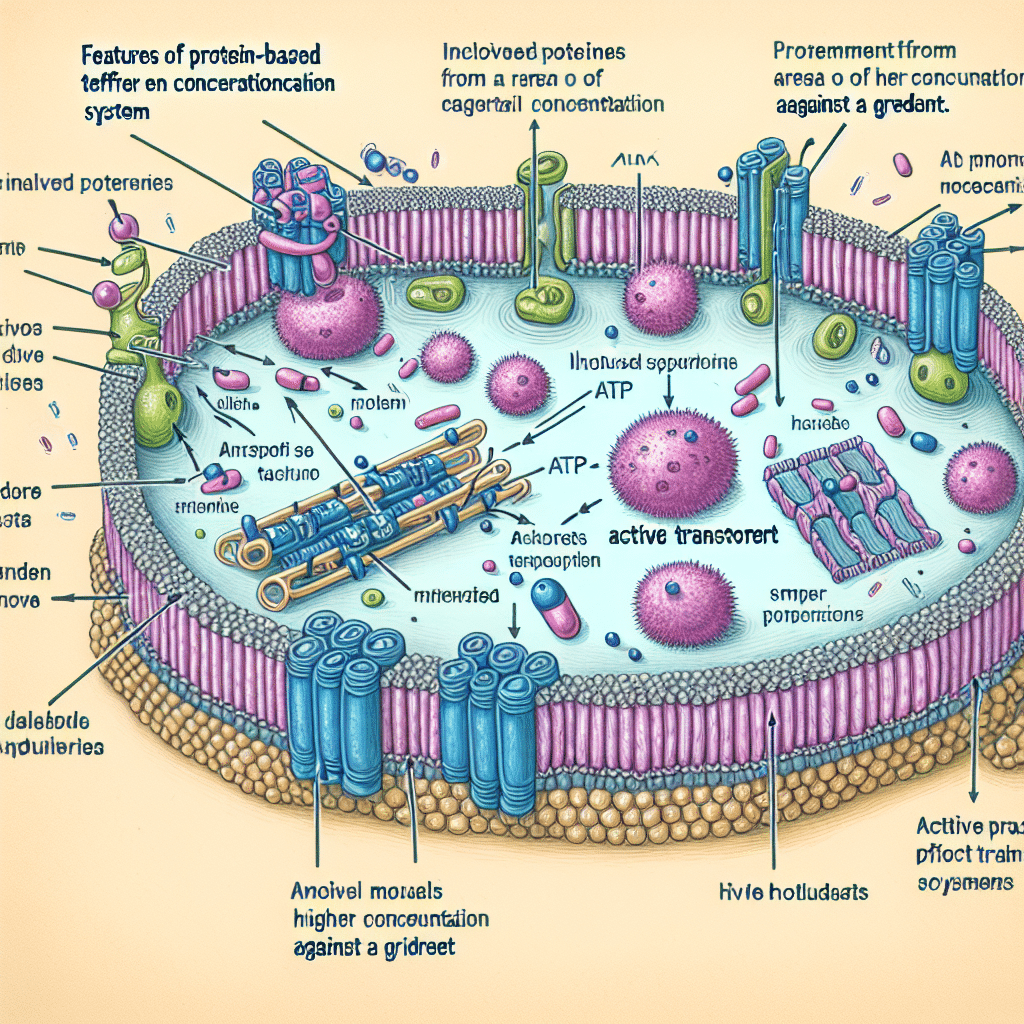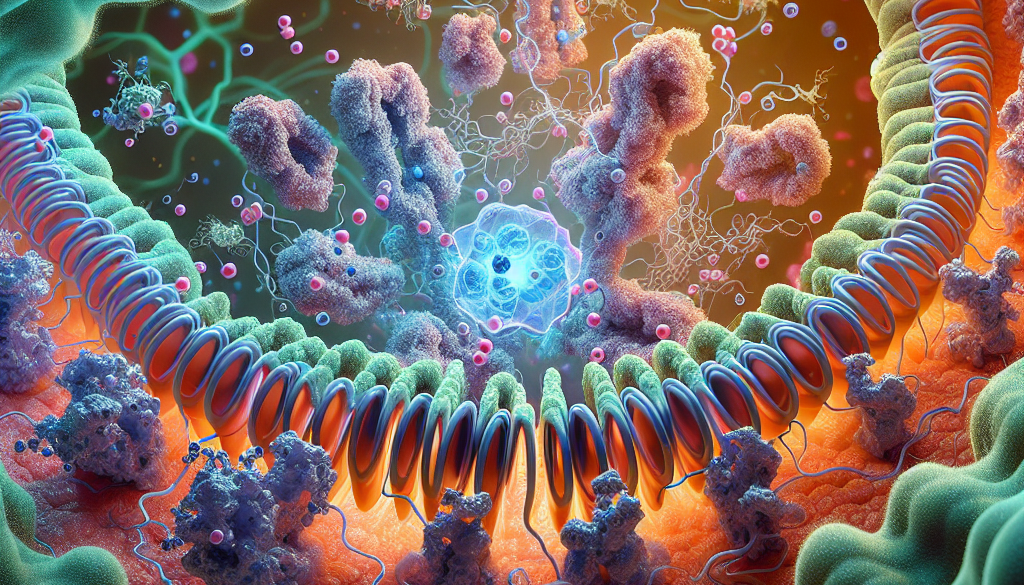Properties of Protein-Based Active Transport: A Deep Dive
-
Table of Contents
- Protein-Based Active Transport: Unveiling the Dynamics and Functions
- Understanding Active Transport
- Key Properties of Protein-Based Active Transport
- Types of Protein-Based Active Transport
- Examples and Case Studies
- Physiological Significance of Protein-Based Active Transport
- Energy Consumption and Efficiency
- Regulation and Control Mechanisms
- Implications in Health and Disease
- Conclusion: The Vital Role of Protein-Based Active Transport
- Discover ETprotein’s High-Quality Protein Products
Protein-Based Active Transport: Unveiling the Dynamics and Functions

Active transport mechanisms are vital for maintaining the proper function of cells and organisms. Among these, protein-based active transport systems are particularly fascinating due to their complex and highly regulated nature. This article delves into the properties of protein-based active transport, exploring how these biological systems operate and their significance in various physiological processes.
Understanding Active Transport
Before we dive into the specifics of protein-based active transport, it’s essential to understand the broader concept of active transport. Active transport refers to the movement of molecules across cell membranes against their concentration gradient. This process requires energy, typically in the form of adenosine triphosphate (ATP), and is mediated by transport proteins embedded in the cell membrane.
Key Properties of Protein-Based Active Transport
Protein-based active transport systems exhibit several key properties that enable them to effectively regulate the movement of substances within biological systems. These properties include specificity, directionality, regulation, and energy dependence.
- Specificity: Transport proteins are highly specific, meaning they can distinguish between similar molecules and selectively transport certain substances.
- Directionality: These proteins can move molecules in a particular direction, either into or out of the cell, which is crucial for maintaining cellular homeostasis.
- Regulation: The activity of transport proteins is tightly regulated by various factors, including the availability of energy sources, co-factors, and signaling molecules.
- Energy Dependence: Active transport processes require energy to function, which is usually derived from the hydrolysis of ATP or from electrochemical gradients.
Types of Protein-Based Active Transport
There are two main types of protein-based active transport: primary active transport and secondary active transport.
- Primary Active Transport: This type directly uses energy from ATP to move molecules against their concentration gradient. A well-known example is the sodium-potassium pump (Na+/K+-ATPase), which maintains the electrochemical gradient in animal cells.
- Secondary Active Transport: Also known as co-transport, this type relies on the energy stored in the form of ionic gradients created by primary active transporters. Examples include the sodium-glucose co-transporter, which facilitates glucose uptake in the intestines.
Examples and Case Studies
Let’s explore some specific examples and case studies that highlight the importance of protein-based active transport in biological systems.
- The Sodium-Potassium Pump: This pump is crucial for nerve impulse transmission and muscle contraction. It actively transports three sodium ions out of the cell and two potassium ions into the cell, creating an electrochemical gradient.
- Calcium Pumps: These pumps play a vital role in muscle contraction, neurotransmitter release, and many other cellular processes by maintaining low intracellular calcium levels.
- ABC Transporters: These proteins are involved in the transport of various molecules, including drugs, across cell membranes. Mutations in ABC transporters can lead to diseases such as cystic fibrosis.
Physiological Significance of Protein-Based Active Transport
Protein-based active transport is essential for numerous physiological processes, including:
- Maintaining cellular ion balance and membrane potential
- Regulating pH levels within cells and organelles
- Controlling the uptake of nutrients and the expulsion of waste products
- Facilitating intercellular communication and signaling pathways
Energy Consumption and Efficiency
Protein-based active transport is an energy-intensive process. The efficiency of these transport systems is a critical factor in cellular energy management. For instance, the sodium-potassium pump consumes a significant portion of a cell’s ATP, especially in excitable cells like neurons and muscle cells.
Regulation and Control Mechanisms
The activity of transport proteins is regulated by various mechanisms, including phosphorylation, allosteric modulation, and feedback inhibition. These regulatory processes ensure that transport activity is closely matched to the cell’s needs.
Implications in Health and Disease
Dysfunction in protein-based active transport can lead to a range of health issues. For example, mutations in the gene encoding for the cystic fibrosis transmembrane conductance regulator (CFTR), an ABC transporter, result in cystic fibrosis. Understanding these transport systems is crucial for developing targeted therapies for such conditions.
Conclusion: The Vital Role of Protein-Based Active Transport
In summary, protein-based active transport is a fundamental aspect of cellular function, enabling cells to maintain homeostasis, communicate, and respond to environmental changes. The specificity, directionality, regulation, and energy dependence of these transport systems underscore their complexity and efficiency. By understanding the properties and mechanisms of protein-based active transport, researchers can better comprehend physiological processes and develop treatments for related diseases.
Discover ETprotein’s High-Quality Protein Products
If you’re looking for premium protein ingredients for your products, consider ETprotein’s offerings. Their extensive range of plant proteins, including organic rice protein, pea protein, and various seed proteins, are ideal for a variety of applications in the food, beverage, and supplement industries. With a commitment to quality, non-GMO, and allergen-free products, ETprotein is your go-to source for plant-based protein solutions.
About ETprotein:
ETprotein, a reputable plant protein vegan protein Chinese factory manufacturer and supplier, is renowned for producing, stocking, exporting, and delivering the highest quality organic bulk vegan protein and plant proteins. They include Organic rice protein, clear rice protein, pea protein, clear pea protein, watermelon seed protein, pumpkin seed protein, sunflower seed protein, mung bean protein, peanut protein etc. Their offerings, characterized by a neutral taste, non-GMO, allergen-free attributes, cater to a diverse range of industries. They serve nutraceutical, pharmaceutical, cosmeceutical, veterinary, as well as food and beverage finished product distributors, traders, and manufacturers across Europe, USA, Canada, Australia, Thailand, Japan, Korea, Brazil, and Chile, among others.
ETprotein specialization includes exporting and delivering tailor-made protein powder and finished nutritional supplements. Their extensive product range covers sectors like Food and Beverage, Sports Nutrition, Weight Management, Dietary Supplements, Health and Wellness Products, and Infant Formula, ensuring comprehensive solutions to meet all your protein needs.
As a trusted company by leading global food and beverage brands and Fortune 500 companies, ETprotein reinforces China’s reputation in the global arena. For more information or to sample their products, please contact them and email sales(at)ETprotein.com today.












